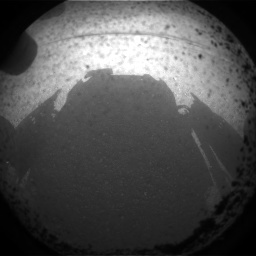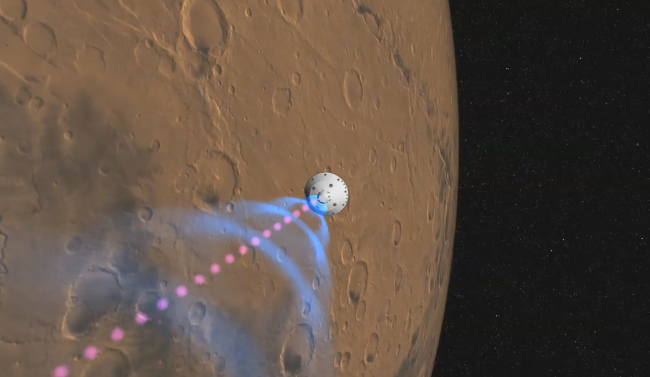
A chorus of cheers and applause echoed through the NASA Jet Propulsion Laboratory on Sunday night after the most high-tech interplanetary rover ever built sent a signal to Earth. It had survived a harrowing plunge through the thin Mars atmosphere.
``Touchdown confirmed,'' said engineer Allen Chen. ``We're safe on Mars.''
Minutes after touchdown, Curiosity beamed back the first pictures from the surface showing its wheel and its shadow, cast by the afternoon sun.
It was NASA's seventh landing on Earth's neighbor; many other attempts by the U.S. and other countries to zip past, circle or set down on Mars have gone awry.
The arrival was an engineering tour de force, debuting never-before-tried acrobatics packed into ``seven minutes of terror'' as Curiosity sliced through the Martian atmosphere at 13,000 mph (20,920.5 kph).
In a Hollywood-style finish, cables delicately lowered the rover to the ground at a snail-paced 2 mph. A video camera was set to capture the most dramatic moments _ which would give earthlings their first glimpse of a touchdown on another world.

Over the next two years, Curiosity will drive over to a mountain rising from the crater floor, poke into rocks and scoop up rust-tinted soil to see if the region ever had the right environment for microscopic organisms to thrive. It's the latest chapter in the long-running quest to find out whether primitive life arose early in the planet's history.
The voyage to Mars took more than eight months and spanned 352 million miles (566 million kilometers). The trickiest part of the journey? The landing. Because Curiosity weighs nearly a ton, engineers drummed up a new and more controlled way to set the rover down. The last Mars rovers, twins Spirit and Opportunity, were cocooned in air bags and bounced to a stop in 2004.
The plans for Curiosity called for a series of braking tricks, similar to those used by the space shuttle, and a supersonic parachute to slow it down. Next: Ditch the heat shield used for the fiery descent.
And in a new twist, engineers came up with a way to lower the rover by cable from a hovering rocket-powered backpack. At touchdown, the cords cut and the rocket stage crashed a distance away.
The nuclear-powered Curiosity, the size of a small car, is packed with scientific tools, cameras and a weather station. It sports a robotic arm with a power drill, a laser that can zap distant rocks, a chemistry lab to sniff for the chemical building blocks of life and a detector to measure dangerous radiation on the surface.
It also tracked radiation levels during the journey to help NASA better understand the risks astronauts could face on a future manned trip.
After several weeks of health checkups, the six-wheel rover could take its first short drive and flex its robotic arm.
The landing site near Mars' equator was picked because there are signs of past water everywhere, meeting one of the requirements for life as we know it. Inside Gale Crater is a 3-mile- (5-kilometer-) high mountain, and images from space show the base appears rich in minerals that formed in the presence of water.
Previous trips to Mars have uncovered ice near the Martian north pole and evidence that water once flowed when the planet was wetter and toastier unlike today's harsh, frigid desert environment.
Curiosity's goal: to scour for basic ingredients essential for life including carbon, nitrogen, phosphorous, sulfur and oxygen. It's not equipped to search for living or fossil microorganisms. To get a definitive answer, a future mission needs to fly Martian rocks and soil back to Earth to be examined by powerful laboratories.
The mission comes as NASA retools its Mars exploration strategy. Faced with tough economic times, the space agency pulled out of partnership with the European Space Agency to land a rock-collecting rover in 2018. The Europeans have since teamed with the Russians as NASA decides on a new roadmap.
Despite Mars' reputation as a spacecraft graveyard, humans continue their love affair with the planet, lobbing spacecraft in search of clues about its early history. Out of more than three dozen attempts _ flybys, orbiters and landings _ by the U.S., Soviet Union, Europe and Japan since the 1960s, more than half have ended disastrously.
One NASA rover that defied expectations is Opportunity, which is still busy wheeling around the rim of a crater in the Martian southern hemisphere eight years later. (AP)
<관련 한글 기사>
화성에 착륙한 로봇, 외계생명 흔적 찾는다
미국 항공우주국(NASA)의 화성 탐사 로봇 '큐리오시티'가 미 동부시간으로 6일 오전 1시30분(한국시간 오후 2시30분)께 화성 표면에 성공적으로 착륙했다.
NASA 제트추진연구소(JPL) 우주비행 관제센터의 한 연구원은 "착륙이 확인됐다"고 밝혀 착륙성공 사실을 알렸다.
큐리오시티는 착륙 직후 후방에 달린 카메라로 화성의 모습을 찍은 흑백사진 3장을 전송했다. 이들 사진에는 화성 표면에 생긴 큐리오시티의 그림자와 몸체에 달린 바퀴의 모습이 각각 담겼다.
NASA 관제센터는 큐리오시티가 화성 적도 아래 분화구인 게일 크레이터의 예정된 지점에 무사히 착륙한 것으로 보인다고 밝혔다.
착륙 이후 큐리오시티의 정확한 상태는 아직 확인되지 않았다.
큐리오시티는 착륙 최종 단계에서 중력의 힘으로 가속, 시간당 2만1천240㎞의엄청난 속력으로 화성 대기권에 돌입했다.
이어 초음속 낙하산과 로켓 추진 스카이 크레인을 통해 모선의 속도를 줄인 뒤 공중에서 줄에 매달린 탐사로봇을 지상에 내려놓는 데 성공했다.
큐리오시티의 화성 대기권 돌입부터 착륙까지 총 7분간의 복잡하고 지난한 과정 이 지나고 착륙 성공 사실이 발표되자 관제센터는 환호성과 박수갈채로 가득 찼다.
과학자들은 NASA 직원들에게 '마스(Mars)' 초콜릿을 나눠주며 성공적인 화성 착륙을 기념했다.
버락 오바마 대통령은 NASA의 이번 위업을 미국 자부심의 한 원천이라고 표현하며 극찬했다.
오바마 대통령은 성명을 통해 "큐리오시티의 성공적인 착륙은 먼 미래에까지 미국 자부심의 한 정점으로 남을 것"이라며 "이번 성공은 아무리 긴 역경이 있어도 우 리의 유일무이한 독창성과 투지에 비할 수 없음을 드러내는 것"이라고 말했다.
찰스 볼든 NASA 국장은 큐리오시티 관련 과학 실험들에 참여한 모든 국가에 박수를 보냈다.
볼든 국장은 "오늘은 미국과 미국인, 그리고 큐리오시티에 기여한 모든 협력국 들에 엄청난 날"이라고 말했다.
이제 큐리오시티는 수 주 또는 수개월 후부터 첨단 카메라와 무선 분석장비를 갖춘 로봇을 통해 화성 표면을 돌아다니며 흙과 암석을 굴착 채취해 생명체의 존재를 가능하게 하는 물과 같은 환경을 찾는 임무를 수행하게 된다.





![[Herald Interview] 'Amid aging population, Korea to invite more young professionals from overseas'](http://res.heraldm.com/phpwas/restmb_idxmake.php?idx=644&simg=/content/image/2024/04/24/20240424050844_0.jpg&u=20240424200058)


![[Pressure points] Leggings in public: Fashion statement or social faux pas?](http://res.heraldm.com/phpwas/restmb_idxmake.php?idx=644&simg=/content/image/2024/04/23/20240423050669_0.jpg&u=)










